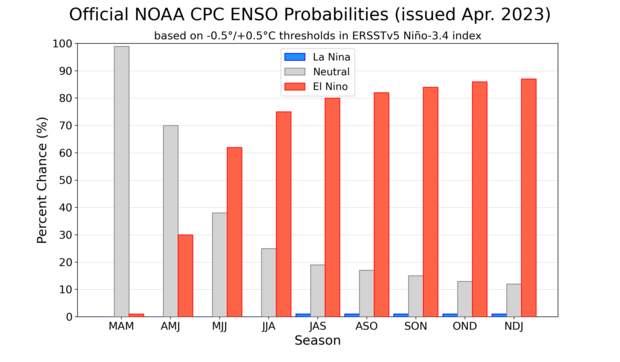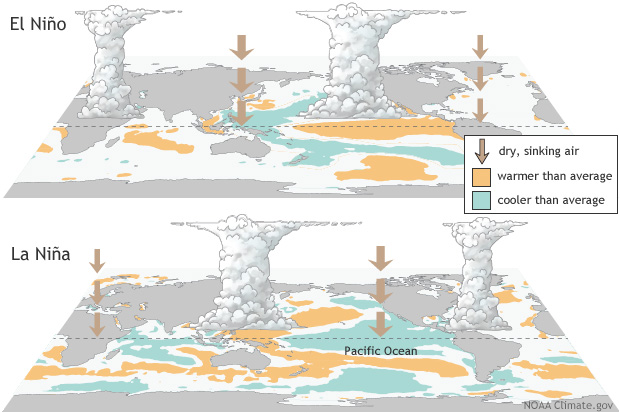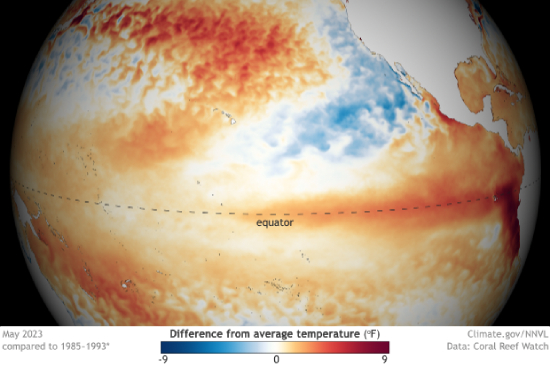MAY 1, 2023 - From Axios on 19 April 2023 comes an article titled Rapidly developing El Niño set to boost global warming. Here’s the lead: “A double whammy of natural climate cycles and human-caused climate change will likely make next year Earth’s warmest on record, climate experts tell Axios.”
The big picture, according to Axios, is that “forecasters now expect that a moderate El Niño, the climate pattern characterized by warmer-than-usual sea surface temperatures, will develop this summer, bringing sweeping shifts to weather patterns worldwide.”
The article continues thusly with a section titled, What’s happening: “Three straight years of La Niña, which features cooler-than-usual sea surface temperatures in the tropical Pacific, have given way to a rapid transition to an El Niño state.” In addition, the National Oceanic and Atmospheric Administration declared an El Niño watch about two weeks ago, “putting 62% odds of an event setting up during May to July.” In addition, according to a meteorologist who leads the El Niño Southern Oscillation team at NOAA’s Climate Prediction Center, the odds of an El Niño event increase to about 85% later this year.
The article points out, as I indicated in a recent video in this space, that the planet reached its warmest temperature in 2016, which was an El Niño year. In addition, the past eight years were the warmest such period on record. Furthermore, ocean temperatures have reached unprecedented levels in the last few weeks.
According to climate scientist Zeke Hausfather, “model projections have been leaning toward a moderate-to-strong El Niño by the fall and winter.” Hausfather said that such an event could boost global temperatures by about 0.2°C in addition to the ongoing human-caused warming trend.
Hausfather echoed Adam Scaife, head of long-range prediction of the U.K. Met Office. Both indicated that the developing El Niño Southern Oscillation could cause the global-average temperature to reach the 1.5°C temperature mentioned in the Paris Agreement.
In other words, the lies continue from paid climate scientists and corporate media outlets. Not only did we already eclipse the 1.5°C Rubicon, but we also sailed beyond 2°C. Again, I’m not a climate scientist, and yet I know that renowned Australian professor Andrew Y. Glikson wrote in his book The Event Horizon that the planetary temperature already exceeds 2°C. The book was published on 9 October 2020. It was undoubtedly written a year or two before then. At the very least, it was written, reviewed, and re-written more than three years ago.
Here’s the signature line from Glikson’s 9 October 2020 book, The Event Horizon. Specifically, this line comes from the abstract of Chapter 5, which you can easily find online. “During the Anthropocene greenhouse gas forcing has risen by more than 2.0 W/m2, equivalent to more than 2°C above pre-industrial temperatures, which constitutes an abrupt event over a period not much longer than a lifetime.”
It is small wonder grain supplies are declining. The ability to grow, store, and distribute grains at scale is imperative to the maintenance of every civilization, including this one. It’s relatively easy to grow grains on a planet with reliably cool temperatures. It’s not nearly so easy to grow grains when the global temperature has risen quickly to a much higher level.
According to a headline from the 18 April 2023 issue of CNBCCNBC, Global rice shortage is set to be the biggest in 20 years. The three key points indicated in this article are (1) Rice production for 2023 is set to log its largest shortfall in two decades, according to Fitch Solutions, (2) “At the global level, the most evident impact of the global rice deficit has been, and still is, decade-high rice prices,” according to Fitch Solutions’ commodities analyst, and (3) There’s a strained supply of rice as a result of the ongoing war in Ukraine, as well as weather woes in rice-producing economies such as China and Pakistan.
China produces more rice and wheat than any other country in the world, and it is currently experiencing the highest level of drought in its rice-growing regions in more than two decades. Major rice-growing areas in France, Germany, and the UK have also been afflicted with the highest level of drought in 20 years. Reduced year-to-year rice production in the United States and the European Union have also contributed to a deficit in worldwide production. As a result of these declines in productivity, many countries will be forced to draw down their domestic stockpiles, if they have them.
The global shortfall for the 2022/2023 harvest is expected to be 8.7 million tonnes. That will mark the largest global rice deficit since 2003/2004, when the global rice markets generated a deficit of 18.6 million tonnes. And, of course, we’ve added many additional mouths to feed on this planet during the last decade.
A day after this story came out in CNBC, USA Today ran this headline: USA Today ran this headline: Global rice shortage possible in 2023, prices are expected to remain high, analysts say. Here’s the lead from an article published on 19 April 2023: “In 2023, the global market for rice could face its biggest shortage in decades, according to industry analysts.” In typical fashion for USA Today, the story blames the Russians: “Putin’s war in Ukraine drastically pushed up the cost of wheat, which in turn has increased demand for grain alternatives like rice.”
The story in USA Today fails to mention climate change while pointing out that flash floods and severe droughts contributed to the reduced production of grains. The flash floods and severe droughts must have been coincidental events. How inconvenient.
Cutting to the chase, finally, three interconnected points are worthy of mention. First, every civilization requires the ability to grow, store, and distribute grains at a large scale. Second, the ability to grow, store, and distribute grains at a large scale depends upon a stable, cool climate. Third and finally, Earth is losing its long-time stable, cool climate. As a result, this set of living arrangements faces a dire threat. And, as a result of the threat to this set of living arrangements, all life on Earth faces an existential threat.
I’ve referred to these three key points many times during the last decade. This is neither rocket science nor brain surgery, much less rocket surgery or brain science. This is easy to understand. Yet I find myself providing the details repeatedly because we have a tough time grasping our own deaths, much less the extinction of our species. And extinction of our species as part of the extinction of all life on Earth is simply too staggering for the masses to comprehend.
On the topic of staggering, I’ll continue with the same … staggering on, trying to explain the simplest of concepts that we simply refuse to believe. It doesn’t bring me joy. Nonetheless, I’m a huge believer in tracking the truth at the end of the evidentiary path. Please join me.
ENSO Redux, Again
MAY 25, 2023
As often occurs when we release a video, abundant, relevant information appeared immediately after we posted ENSO Redux on this channel on 1 May 2023. That video indicated the strong possibility of an overdue El Niño Southern Oscillation occurring later this year.
This video is designed to catch up with the recent information about the likelihood of an El Niño Southern Oscillation, shortened to ENSO.
The bottom line, of sorts, comes from the World Meteorological Organization, which released its April 2023 report on 8 May 2023 in Geneva, Switzerland. The report indicates that the world must prepare for a warm El Niño current that will raise temperatures to record levels this year: chances of an ENSO will reach 60% from May to July and then increase to 70% between June and August and 80% between July and September. It’s not clear to me how we are expected to prepare for loss of habitat for our species on the only planet known to support life. Regardless, this video again addresses the likely consequences of the coming ENSO, and how we might respond.
Apparently, the “climate change signal” was not coming through clearly enough already. The likely ENSO later this year will overcome the opinions of even the most rabid deniers, according to climate reporters and climate scientists. Personally, I have my doubts.
According to the piece from The Weather Network, the world’s oceans began setting heat records on a near-daily basis in early March. By the end of March, the average sea surface temperature exceeded 21 degrees C for the first time since record-keeping began. The response from paid climate scientists is exactly as I’ve come to expect. Consider this quote from Michael Meredith, an oceanographer and Science Leader at the British Antarctic Survey: “The fact that it is warming as much as it has been is a real surprise, and very concerning.” A surprise, really? I understand the concern, but I’m surprised that anyone paying attention to the climate is, well, surprised that the ocean is warming.
Adding to the surprises—both from reporters and me—comes this quote from Emily Becker, the lead writer for the National Oceanic and Atmospheric Administration’s ENSO blog: “2022 was the 6th warmest year since records began in 1880, and that was with a non-stop La Niña. If El Niño develops this year, it increases the odds of record-warm global temperature.”
Oh, really? The release of heat and greenhouse gases from an overheated ocean will, “increase the odds of record-warm global temperature.” Who’duh thunk it?

Let’s dig a little deeper into this story. From the BBC, in a story published 25 April 2023 comes this headline: “Recent, rapid ocean warming ahead of El Niño alarms scientists.” According to the lede: “This month, the global sea surface hit a new record high temperature. It has never warmed this much, this quickly.” The following line is classic: “Scientists don’t fully understand why this happened.”
Perhaps those scientists could read the Intergovernmental Panel on Climate Change’s 8 October 2018 report, Global Warming of 1.5°. According to this report, published more than four-and-a-half years ago: “These global-level rates of human-driven change far exceed the rates of change driven by geophysical or biosphere forces in the past.” The report then quotes two peer-reviewed papers, before going on: “even abrupt geophysical events do not approach current rates of human-driven change.” In other words, the ongoing, anthropogenic climate change underlies the fastest rate of environmental change in planetary history. Despite this fact being reported by the IPCC and two peer-reviewed articles, “Scientists don’t fully understand why this happened.” Specifically, scientists cannot figure out why the darned ocean is warming so quickly. Back to that story published by the BBC. Immediately after the line, “Scientists don’t fully understand why this happened,” we are told, “But they worry that, combined with other weather events, the world’s temperature could reach a concerning new level by the end of next year.”
A peer-reviewed article is then mentioned in the BBC paper with this line: “An important new study, published last week with little fanfare, highlights a worrying development.” The “important new study” can be reached via an embedded link. If it was published, “with little fanfare,” then I think we can blame corporate media such as the BBC for this oversight. Published in the peer-reviewed Earth System Science Dataon 17 April 2023, the paper is titled, “Heat stored in the Earth system 1960-2020: where does the energy go?” It was written by Karina von Schuckmann and 67 other scholars. The abstract informs us that about 89% of planetary heating is stored in the ocean. This, then, explains why informed people are properly concerned about the coming El Niño Southern Oscillation. After all, as I have reported previously in this space, the ocean acts as something of a battery. The El Niño Southern Oscillation releases heat and greenhouse gases from the storage system known as the world’s ocean. The bigger the ENSO, the more heat and greenhouse gases are released into the atmosphere.

There’s much more information from the open-access, peer-reviewed paper in Earth System Science Data. During the past 15 years, Earth has accumulated almost as much energy as it did in the previous 45 years, with most of the extra energy going into the ocean. The real-world consequences pointed out by the BBC include stunningly high ocean temperatures off the eastern coast of North America. In response, von Schuckmann is quoted by the BBC: “We have doubled the heat in the climate system the last 15 years, I don’t want to say this is climate change, or natural variability or a mixture of both, we don’t know yet. But we do see this change.”
“I don’t want to say this is climate change …” Really? Because I really, really want to say this is climate change. Crazy as it seems, I want to say, quoting the stunningly scientifically conservative IPCC, that this is anthropogenic climate change. We did it. We continue to do it. The responsibility lies at our feet. Most notably, it lies at the feet of a few billionaires, as well as government officials and corporate media outlets working together.
I am surprised by one admission by the BBC, about halfway into the article. The aerosol masking effect is mentioned, albeit briefly: “One factor that could be influencing the level of heat going into the oceans, is, interestingly, a reduction in pollution from shipping. … aerosols that dirty the air also help reflect heat back into space – removing them may have caused more heat to enter the waters.”
Three days after the story was published by the BBC—the one that alarmed scientists—Wired published a story titled, An Ominous Heating Event is Unfolding in the Oceans. Here’s the subhead: “Average sea surface temperatures have soared to record highs, and stayed there. It’s a worrying signal of an ocean in crisis.” Yes, it’s worrying, and yes, life in the ocean and life on the planet is in the midst of a crisis.
The story in Wired quotes two surprised scientists, the lead scientist at Berkeley Earth, a nonprofit that gathers climate data, and a physical scientist and oceanographer at the National Oceanic and Atmospheric Administration. The former said, “It’s surprising to me that we’re this far off the trajectory. Usually when you have a particular warming event, we’re beating the previous record by a little bit. Right now we’re sitting well above the past records for this time of a year, for a considerable period of time.” The latter said, “Both the atmosphere and oceans are becoming warmer and warmer. If the atmosphere pushes the ocean, then the ocean will push back into the atmosphere.”
The story in Wired, again published on 28 April 2023, indicates a 62% chance of a classic ENSO developing by June or July, with a 40% chance of a strong ENSO. The story concludes with a researcher from the Monterey Bay Aquarium Research Institute wondering whether the ocean will become more of a desert over time. He points out that one of the consequences of heating the ocean’s surface is altered marine nutrient cycling. The story ends with him pondering whether the ocean will become more of a desert over time.
That’s a fine question: Will the ocean become more of a desert over time? If so, how soon? Considering the ongoing rate of environmental change on land and in the ocean, it appears desertification of terrestrial and marine systems will attract the attention of even paid climate scientists, government officials, and the corporate media. Well, won’t that be something?
An update from LiveScience published on 12 May 2023 is titled, Significant El Niño event is almost guaranteed this year, experts warn. And it could be a big one. The subhead tells the story: “NOAA researchers have predicted that an ocean-heating event known as El Niño is probably going to arrive in the next few months and persist into 2024.” The lead indicates there is more than a 90% chance of ENSO arriving within the coming few months, “and there is a good chance it will persist into 2024 and have a widespread impact, experts have warned.”
There is plenty of additional material about the El Niño Southern Oscillation that almost certainly lies in our near future. We will try to share some of that material with future videos in this space. In the meantime, please like and share this video. Share it even with people you don’t like. It’s likely to ruin their day, after all. And why limit that experience to you and me?
ENSO Looms Large
JUN 12, 2023 Update
We have indicated that we would relay any new information about the impending El Niño Southern Oscillation. Alas, we have new information. Alas, it’s not good news.
Our latest update included information from The Weather Network on 8 May 2023. Specifically, this line came from NOAA’s director of the Tropical Moored Buoy Array Program, Michael McPhaden: “The recent ‘triple dip’ La Niña has come to an end. Now that it’s over, we are likely seeing the climate change signal coming through loud and clear.”
Apparently, the “climate change signal” was not coming through clearly enough already. The likely ENSO later this year will overcome the opinions of even the most rabid deniers, according to climate reporters and climate scientists. Personally, I have my doubts.
From the BBC, in a story published 25 April 2023 comes this headline: “Recent, rapid ocean warming ahead of El Niño alarms scientists.” According to the lede: “This month, the global sea surface hit a new record high temperature. It has never warmed this much, this quickly.” The following line is classic: “Scientists don’t fully understand why this happened.”
Perhaps those scientists could read the Intergovernmental Panel on Climate Change’s 8 October 2018 report, Global Warming of 1.5°. According to this report, published more than four-and-a-half years ago: “These global-level rates of human-driven change far exceed the rates of change driven by geophysical or biosphere forces in the past.” The report then quotes two peer-reviewed papers, before going on: “even abrupt geophysical events do not approach current rates of human-driven change.” In other words, the ongoing, anthropogenic climate change underlies the fastest rate of environmental change in planetary history. Despite this fact being reported by the IPCC and two peer-reviewed articles, “Scientists don’t fully understand why this happened.” Specifically, scientists cannot figure out why the darned ocean is warming so quickly. Back to that story published by the BBC. Immediately after the line, “Scientists don’t fully understand why this happened,” we are told, “But they worry that, combined with other weather events, the world’s temperature could reach a concerning new level by the end of next year.”
But enough about the video we released in this space on 24 May of this year. I’ll turn to new information, starting with a report from Severe Weather Europepublished on 7 May2023. The story is headlined El Niño is now developing rapidly, with long-range data already showing a strong event is likely, impacting the Fall and Winter Weather. Here’s the extensive lede: “El Niño is developing rapidly, with an official watch current in effect, issued by NOAA. A moderate to strong El Niño event is expected to occur, with global weather impacts in the second half of the year and over the Winter season of 2023/2024. Based on the latest global anomaly data, this El Niño might be something we have never seen before in such an environment.” Let’s unpack this latter sentence.
First, “this El Niño might be something we have never seen before.” As I have indicated a few times in this space, a 2017 peer-reviewed paper by professor James Hansen and colleagues indicates we currently occupy the warmest Earth with civilization present. As a result, the conclusion by Severe Weather Europe is exactly correct: We are indeed headed for “something we have never seen before.”
Second, “this El Niño might be something we have never seen before in such an environment.” We have never experienced a warmer planet with civilization present, and therefore with such a strong potential for additional overheating via loss of aerosol masking. If, “such an environment” means accelerated warming on an already overheated planet, then, again, I agree: We are headed for “something we have never seen before in such an environment.”
As I have mentioned previously in this space, we are coming out of a record-setting, triple-dip La Niña. In other words, we are transitioning from a period of exceptional cooling to one of exceptional warming. As I have mentioned repeatedly in this space, the rate of environmental change is critically important to the ability of populations and species to adapt. If the rate of environmental change exceeds the ability of organisms to adapt, those organisms will go extinct.
As I have also previously mentioned in this space, ongoing and projected rates of environmental change outstrip the ability of vertebrates and mammals to adapt. Both conclusions were and are based on peer-reviewed papers going back to 2013. Specifically, a peer-reviewed paper by Quintero and Wiens published on 26 June 2013 in Ecology Letters found that projected rates of environmental change would require rates of niche evolution that are 10,000 times faster than rates typically observed among species. Mammals cannot keep up, as reported in the prestigious peer-reviewed Proceedings of the National Academy of Scienceswith a paper by Matt Davis and two other scholars published on 15 October 2018. In other words, again, vertebrates and mammals cannot keep up. Humans are vertebrate mammals. It gets worse.
The exceptionally conservative political body known as The Intergovernmental Panel on Climate Change concluded that the ongoing rate of environmental change is the fastest in planetary history. The IPCC reached this conclusion in its 8 October 2018 report, Global Warming of 1.5o. Specifically, this report included this line: “even abrupt geophysical events do not approach current rates of human-driven change.” The expected ENSO will accelerate the fastest rate of environmental change in planetary history.
Back to that 7 May 2023 report from Severe Weather Europe. Included is this line: “The cold La Niña anomalies quickly broke down over the Winter, with warm anomalies emerging in early Spring.” Obviously, the report is referring to the North American winter and spring. Winter is behind us. Spring will last another couple of weeks.
The report from Severe Weather Europe goes on to report that sea-level rise is already well underway, another indication that an El Niño event is off to a strong start. As if additional information is needed, the report also indicated that a sub-surface Kelvin wave was growing larger and spreading east and upward. That was in April. As the report indicates, “a strong subsurface warm pool is the main pre-condition to kickstart an El Niño event.” This “strong subsurface warm pool” is ongoing.
As reported by Severe Weather Europe, the NOAA Climate Prediction Center issued an official El Niño watch. “This watch continues, with the latest outlook giving a greater than 90% chance of an El Niño impacting the next Winter season of 2023/2024.” Again, that’s next winter in the Northern Hemisphere. As stated in the report by Severe Weather Europe, “strong warm anomalies are now entering the eastern parts of the ENSO regions, exceeding 4 degrees Celsius.”
The Severe Weather Europe also concludes that warm sea surface temperatures, which indicate the ENSO, are “the warmest in the past 40 years, and likely even more. And this is with the El Niño just starting to develop.” It refers to the current circumstances as, “a very unique situation, with abnormally warm North Pacific, North Atlantic, and the rest of the globe running warmer on average. Usually, there is a larger contrast with then El Niño, but this year, the oceans are already running record warmest, without the El Niño properly developed yet.”
There you have it: “the oceans are already running record warmest, without the El Niño properly developed yet.” The proper development of the El Niño looms large. Will it be sufficient to destroy habitat for human animals on Earth? We shall see, and soon.
Author
"Dr. Guy McPherson is an internationally recognized speaker, award-winning scientist, and the world’s leading authority on abrupt climate change leading to near-term human extinction. He is professor emeritus at the University of Arizona, where he taught and conducted research for twenty years. His published works include 14 books and hundreds of scholarly articles. Dr. McPherson has been featured on TV and radio and in several documentary films. He is a blogger, cultural critic, and co-host of his own radio show “Nature Bats Last.” Dr. McPherson speaks to general audiences across the globe, and to scientists, students, educators, and not-for-profit and business leaders who seek their best available options when confronting Earth’s cataclysmic changes." source







